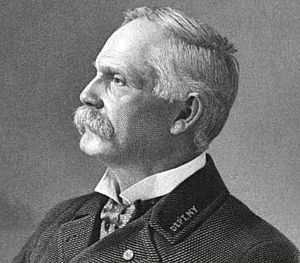Albert D. Shaw facts for kids
Quick facts for kids
Albert Duane Shaw
|
|
|---|---|

Albert Duane Shaw, Congressman from New York
|
|
| Member of the U.S. House of Representatives from New York's 24th district |
|
| In office November 6, 1900 – February 10, 1901 |
|
| Preceded by | Charles A. Chickering |
| Succeeded by | Charles L. Knapp |
| Member of the New York State Assembly from Jefferson County's 2nd district | |
| In office January 1, 1867 – December 31, 1867 |
|
| Preceded by | Nelson D. Ferguson |
| Succeeded by | Andrew Cornwall |
| Personal details | |
| Born | December 21, 1841 Lyme, New York, U.S. |
| Died | February 10, 1901 (aged 59) Washington, D.C., U.S. |
| Resting place | Brookside Cemetery, Watertown, New York, U.S. |
| Political party | Republican |
| Military service | |
| Allegiance | United States (Union) New York State |
| Branch/service | Union Army New York National Guard |
| Years of service | 1861–1866 (Army) 1867-1868 (National Guard) |
| Rank | Corporal (Army) Colonel (National Guard) |
| Unit | 35th New York Volunteer Infantry Regiment (Army) |
| Commands | 36th New York Infantry Regiment (National Guard) |
| Battles/wars | American Civil War |
Albert Duane Shaw (born December 21, 1841 – died February 10, 1901) was an important American leader. He was a politician and worked for the government from New York. He fought in the American Civil War for the Union Army. Later, he became the top leader of a group for Civil War veterans called the Grand Army of the Republic. He also served as a U.S. Representative for New York.
Contents
Early Life and Education
Albert Duane Shaw was born on December 21, 1841, in Lyme, New York. His parents were Henry and Sally Ann Shaw. He grew up on his family's farm in Lyme.
He went to local schools and later attended Union Academy in Belleville. He also studied at St. Lawrence University in Canton. However, he left college early to join the military.
Military Service
Shaw joined the Union Army in June 1861 during the American Civil War. He started as a private in Company A, 35th New York Volunteer Infantry Regiment. He was later promoted to corporal. He served until June 1863, when his regiment was discharged.
Civil War Battles
Shaw's regiment was active in Virginia and Maryland. They helped build forts like Fort Tillinghast and Fort Craig. They also did guard duty around Falls Church, Virginia and Falmouth, Virginia.
He took part in several battles in 1862, including:
- Rappahannock Station
- White Sulphur Springs
- Gainesville
- Second Battle of Bull Run
- Chantilly
- South Mountain
- Antietam
- Fredericksburg
In 1863, his regiment guarded the Aquia Creek railroad. They returned to New York in May to be discharged.
After the War
After leaving the army, Shaw worked for the Army's provost marshal's office in Watertown. He served there until the war ended. The provost marshal's job was to keep track of men who could serve in the military. They also made sure men who were paid to join actually went to the front lines. This office also found and arrested soldiers who left their units without permission.
After the war, Shaw became a colonel in the New York National Guard. He commanded the 36th Infantry Regiment. He left this role in 1868 to become a U.S. consul.
Early Career
After the Civil War, Shaw went back to St. Lawrence University but did not finish his degree. In 1866, he was elected to the New York State Assembly. He represented the 2nd District of Jefferson County as a Republican. He served in the state legislature in 1867.
Diplomatic Service
In 1868, Shaw was appointed as the United States consul in Toronto, Canada. He served in this role for ten years, until 1878. The Secretary of State, Hamilton Fish, praised Shaw's reports as excellent.
In 1878, Shaw became the U.S. consul in Manchester, England. He worked there until 1885. When Grover Cleveland became president, he replaced Shaw with a new appointee.
Later Career
After leaving Manchester, Shaw lived in Watertown. He became a popular speaker for holidays and events. He often spoke at dedications for Civil War memorials. He also gave speeches for Republican political campaigns.
Shaw was very involved in Watertown's community. He served as president of the Young Men's Christian Association (YMCA). He was also the president of the local chamber of commerce.
Grand Army of the Republic
Shaw was a very active member of the Grand Army of the Republic (GAR). This was a group for veterans of the Union Army. In 1897, he was chosen as the department commander for New York. In 1899, he was elected as the national Commander-in-Chief of the GAR. He held this important position until 1900.
Congressman
In 1900, Shaw was elected as a Republican to the 56th Congress. He filled a spot that became open after the death of Charles A. Chickering. He was reelected to the 57th Congress. However, he passed away before his new term began on March 4, 1901. Shaw served in Congress from November 6, 1900, until his death.
Death and Burial
Albert Duane Shaw died in Washington, D.C. on February 10, 1901. Reports said he returned to his hotel room after a banquet. He was found dead the next morning. Doctors said he died from a stroke. He was buried at Brookside Cemetery in Watertown, New York.
Family
In 1872, Albert Duane Shaw married Mary Sherwood Keith from Chicago. They had three children together:
- Henry L. Keith Shaw
- Mabel Keith Shaw
- Minnie Scott Shaw

